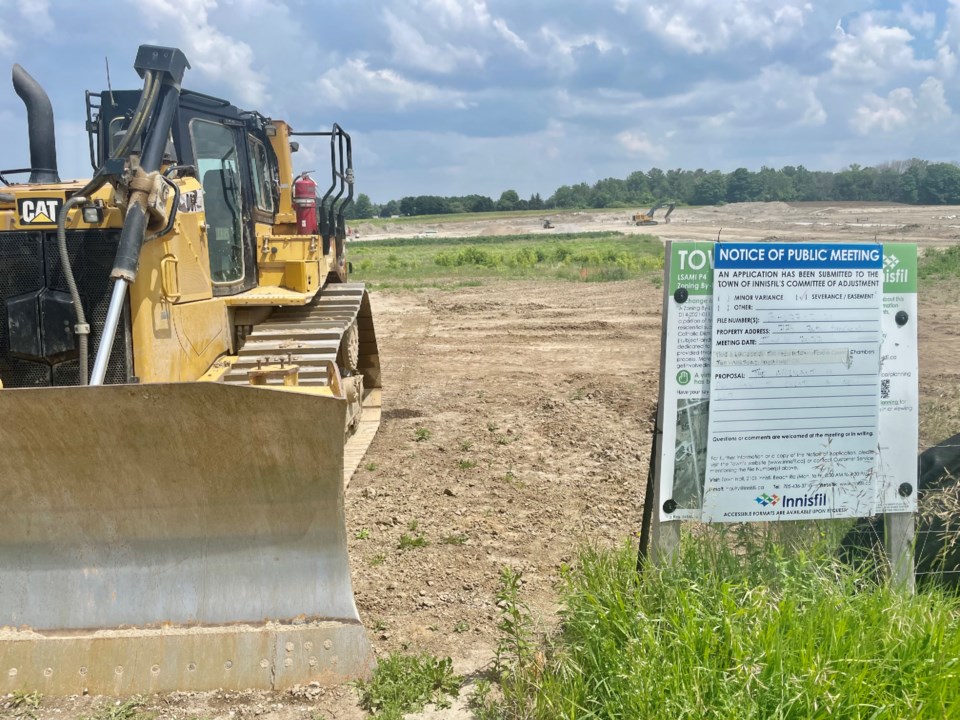The Town of Innisfil thinks it might have a way to make its planning process more efficient without eliminating vital public participation.
Council heard from David Riley of SGL Planning & Design at its June 28 meeting on bringing a community planning permit system (CPSS) to the entire municipality. Since 2019, the Our Shore CPPS has been in effect for applicable lands adjacent to the Lake Simcoe shoreline.
Moving that process town-wide could give council and staff a greater say in how development occurs in Innisfil.
“There’s a streamlined approval process, with shorter approval timelines, which in turn can help get housing to market quicker,” Riley said. “It can really help support those local priorities and provide flexibility to define how land can be used.”
A CPPS is a land-use planning tool that municipalities in Ontario can utilize, combining applications for zoning bylaw amendments, minor variances and site plans into one application and review/approval process. It is more like a zoning bylaw than an Official Plan, as it gives specific land use provisions, regulating matters including permitted uses, building heights, parking, etc.
While Bill 23 has made changes to the Planning Act, causing municipalities across Ontario to overhaul planning processes, the CPPS structure has been largely untouched, and even though the province hasn’t come out and said as much, Riley thinks he has an idea why.
“(In) all of this legislation, nothing really changed as it pertains to (CPPS), which is kind of nice because the province… already see this as a streamlined process,” he opined. “It’s very flexible in the way it can be implemented, but the bottom line is that approvals are issued within 45 days.”
That 45-day limit is mandated under the Planning Act. One of the ways it differs from traditional zoning bylaw amendment processes is that there is no legislative requirement to provide public notices for CPPS applications, meaning that the efficiency created could come at the expense of resident concerns.
That didn’t sit well with Deputy Mayor Kenneth Fowler.
“When we’re talking about public meetings and restricting them, I don’t like the idea of not allowing people to express their voices and opinions in regard to the development of the town as a whole,” Fowler said. “If something is going to be built near me, that affects me directly, why would I not have a say in the matter?”
Fowler was concerned that the cost of streamlining the process would be the voice of the people. Riley, however, explained where the CPPS also differs is in what a municipality can add in.
“The great thing about a CPPS is its flexibility,” Riley said. “What we’ve seen in many of the other communities that have recently implemented a (CPPS) but also those that have had them for quite a long time, they have actually gone beyond the legislative requirement and do have a public process as part of their applications, and that’s something that we as planners would be recommending to the town going forward.”
In a way, the CPPS can help Innisfil ensures its residents have their say on contentious planning issues, even in situations where that might have been eliminated by recent provincial actions.
“Although there have been many recent legislative changes and public consultation is not legislatively required for CPPS, a municipality can still elect to engage the community. Staff anticipate this continuing to be the case through the future development of the town-wide CPPS bylaw,” a staff report to council stated.
“The CPPS can mandate clear public notification and consultation requirements based on the development type being proposed,” the report continued, with the text in bold type for emphasis.
The Our Shore CPPS prescribes greater participation than legislatively mandated already, as do many of the other municipalities in Ontario that already have a town-wide CPPS in place. Riely said in talking to those towns, they found another advantage that can help Innisfil under some of the new development guidelines put in place by the province.
“You can actually use conditional approvals to make sure that some of these community goals and objectives are met,” Riley said. “One of the things that’s really great about the (CPPS) is the idea of conditional approvals. So, if there’s something that’s not addressed immediately, you can still meet that 45-day (requirement) by issuing a conditional approval that is contingent on certain things being implemented or certain community benefits being provided.”
Riley walked council through the proposed implementation of the CPPS, which, barring an appeal to the Ontario Land Tribunal, should come to a conclusion before the end of this term.
Phase one of the project began last year. Since then, consultation has occurred with special interest groups and the community at large, including a virtual public workshop at the end of May. The next phase will see placemaking and sustainable design guidelines be developed before the public is officially brought back into the process in late-2023 and early 2024. At that time, the draft Official Plan amendment, CPPS bylaw and implementation guidelines will be available for comment and revision. It’s hoped that phase four, approval of the amendment and passing of the bylaw will occur by early 2025 at the latest.
Once the bylaw is passed, it will be gradually rolled out throughout the municipality. Implementation will begin with the current area administered by the Our Shore CPPS and the Alcona primary settlement area. From there, all other urban settlement areas of the town will be brought online, followed by villages and hamlets, future settlement/expansion areas and finally, the rest of the municipality.



